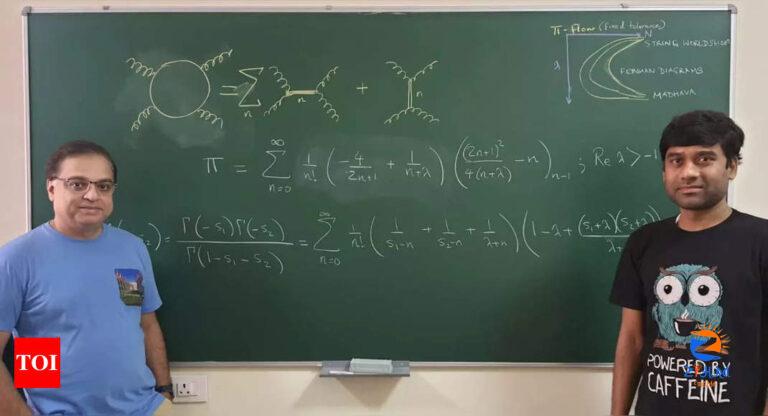
[ad_1]
BENGALURU: In a key breakthrough, IISc physicists have stumbled upon a new series representation for calculating the mathematical constant pi — an irrational number represented with the symbol “π” — while investigating how string theory can explain certain physical phenomena.
The discovery provides an easier way to extract pi from calculations involved in deciphering processes like the quantum scattering of high-energy particles, IISc said on Monday.The study was carried out by Arnab Saha, a post-doc and Aninda Sinha, professor at Centre for High Energy Physics (CHEP), and published in Physical Review Letters.
“The new formula under a certain limit closely reaches the representation of pi suggested by Indian mathematician Sangamagrama Madhava in the 15th century, which was the first ever series for pi recorded in history,” IISc said.
Sinha said their efforts, initially, were never to find a way to look at pi. All they were doing was studying high-energy physics in quantum theory and trying to develop a model with fewer and more accurate parameters to understand how particles interact. “We were excited when we got a new way to look at pi,” Sinha said.
In mathematics, a series is used to represent a parameter such as pi in its component form. If pi is the “dish” then the series is the “recipe”. Pi can be represented as a combination of many numbers of parameters (or ingredients). Finding the correct number and combination of these parameters to reach close to the exact value of pi rapidly has been a challenge.
“The series that Sinha and Saha have stumbled upon combines specific parameters in such a way that scientists can rapidly arrive at the value of pi, which can then be incorporated in calculations, like those involved in deciphering scattering of high-energy particles,” IISc said.
Sinha said physicists (and mathematicians) have missed this so far since they did not have the right tools, which were only found through work his team has been doing with collaborators over the last three years or so.
“In the early 1970s, scientists briefly examined this line of research but quickly abandoned it since it was too complicated,” Sinha said, adding that although the findings are theoretical at this stage, it is not impossible that they may lead to practical applications in the future.
Sinha points to how Paul Dirac worked on the mathematics of the motion and existence of electrons in 1928, but never thought that his findings would later provide clues to the discovery of the positron, and then to the design of Positron Emission Tomography (PET) used to scan the body for diseases and abnormalities.
“Doing this kind of work, although it may not see an immediate application in daily life, gives the pure pleasure of doing theory for the sake of doing it,” Sinha added.
The discovery provides an easier way to extract pi from calculations involved in deciphering processes like the quantum scattering of high-energy particles, IISc said on Monday.The study was carried out by Arnab Saha, a post-doc and Aninda Sinha, professor at Centre for High Energy Physics (CHEP), and published in Physical Review Letters.
“The new formula under a certain limit closely reaches the representation of pi suggested by Indian mathematician Sangamagrama Madhava in the 15th century, which was the first ever series for pi recorded in history,” IISc said.
Sinha said their efforts, initially, were never to find a way to look at pi. All they were doing was studying high-energy physics in quantum theory and trying to develop a model with fewer and more accurate parameters to understand how particles interact. “We were excited when we got a new way to look at pi,” Sinha said.
In mathematics, a series is used to represent a parameter such as pi in its component form. If pi is the “dish” then the series is the “recipe”. Pi can be represented as a combination of many numbers of parameters (or ingredients). Finding the correct number and combination of these parameters to reach close to the exact value of pi rapidly has been a challenge.
“The series that Sinha and Saha have stumbled upon combines specific parameters in such a way that scientists can rapidly arrive at the value of pi, which can then be incorporated in calculations, like those involved in deciphering scattering of high-energy particles,” IISc said.
Sinha said physicists (and mathematicians) have missed this so far since they did not have the right tools, which were only found through work his team has been doing with collaborators over the last three years or so.
“In the early 1970s, scientists briefly examined this line of research but quickly abandoned it since it was too complicated,” Sinha said, adding that although the findings are theoretical at this stage, it is not impossible that they may lead to practical applications in the future.
Sinha points to how Paul Dirac worked on the mathematics of the motion and existence of electrons in 1928, but never thought that his findings would later provide clues to the discovery of the positron, and then to the design of Positron Emission Tomography (PET) used to scan the body for diseases and abnormalities.
“Doing this kind of work, although it may not see an immediate application in daily life, gives the pure pleasure of doing theory for the sake of doing it,” Sinha added.
[ad_2]
